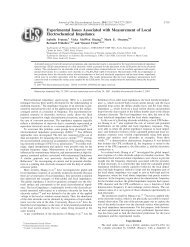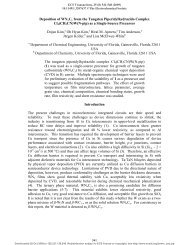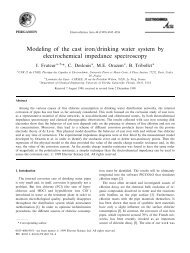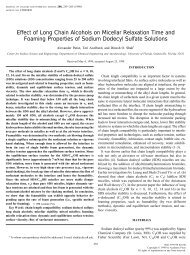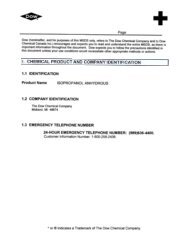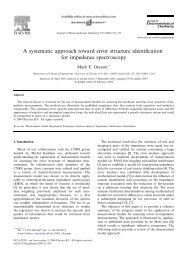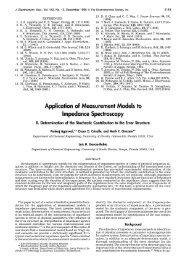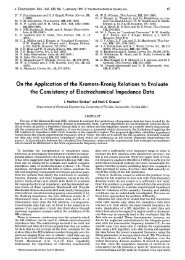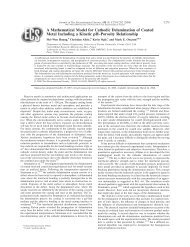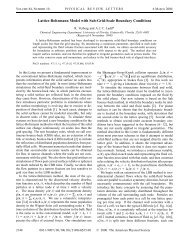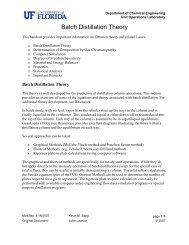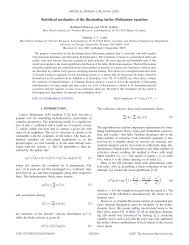Molecular Dynamics and the Rouse Model - An Introduction to the ...
Molecular Dynamics and the Rouse Model - An Introduction to the ...
Molecular Dynamics and the Rouse Model - An Introduction to the ...
You also want an ePaper? Increase the reach of your titles
YUMPU automatically turns print PDFs into web optimized ePapers that Google loves.
<strong>Introduction</strong><br />
Methods<br />
Results<br />
Summary<br />
Appendix<br />
<strong>Molecular</strong> <strong>Dynamics</strong> <strong>and</strong> <strong>the</strong> <strong>Rouse</strong> <strong>Model</strong><br />
<strong>An</strong> <strong>Introduction</strong> <strong>to</strong> <strong>the</strong> Physics of Polymers<br />
Daniel Bridges 1 Dr. <strong>An</strong>iket Bhattacharya 2<br />
1 Department of Physics & Astronomy<br />
Middle Tennessee State University<br />
2 Department of Physics<br />
University of Central Florida<br />
July 28, 2009<br />
Daniel Bridges, Dr. <strong>An</strong>iket Bhattacharya<br />
<strong>Molecular</strong> <strong>Dynamics</strong> <strong>and</strong> <strong>the</strong> <strong>Rouse</strong> <strong>Model</strong>
<strong>Introduction</strong><br />
Methods<br />
Results<br />
Summary<br />
Appendix<br />
Polymers are essential <strong>to</strong> life.<br />
Why am I here?<br />
Polymer physics<br />
Daniel Bridges, Dr. <strong>An</strong>iket Bhattacharya<br />
<strong>Molecular</strong> <strong>Dynamics</strong> <strong>and</strong> <strong>the</strong> <strong>Rouse</strong> <strong>Model</strong>
<strong>Introduction</strong><br />
Methods<br />
Results<br />
Summary<br />
Appendix<br />
Why am I here?<br />
Polymer physics<br />
Don’t sneeze; you might lose some polymers.<br />
We can model a simplified DNA<br />
str<strong>and</strong> as a beaded necklace.<br />
Daniel Bridges, Dr. <strong>An</strong>iket Bhattacharya<br />
<strong>Molecular</strong> <strong>Dynamics</strong> <strong>and</strong> <strong>the</strong> <strong>Rouse</strong> <strong>Model</strong>
<strong>Introduction</strong><br />
Methods<br />
Results<br />
Summary<br />
Appendix<br />
Why am I here?<br />
Polymer physics<br />
Don’t sneeze; you might lose some polymers.<br />
We can model a simplified DNA<br />
str<strong>and</strong> as a beaded necklace.<br />
<strong>Rouse</strong> model: ”Bead-spring<br />
model”<br />
Daniel Bridges, Dr. <strong>An</strong>iket Bhattacharya<br />
<strong>Molecular</strong> <strong>Dynamics</strong> <strong>and</strong> <strong>the</strong> <strong>Rouse</strong> <strong>Model</strong>
Polymers sit in solvents!<br />
<strong>Introduction</strong><br />
Methods<br />
Results<br />
Summary<br />
Appendix<br />
Why am I here?<br />
Polymer physics<br />
Polymer/solvent interaction (varies with temp.) dictates three<br />
situations:<br />
Daniel Bridges, Dr. <strong>An</strong>iket Bhattacharya<br />
<strong>Molecular</strong> <strong>Dynamics</strong> <strong>and</strong> <strong>the</strong> <strong>Rouse</strong> <strong>Model</strong>
Polymers sit in solvents!<br />
<strong>Introduction</strong><br />
Methods<br />
Results<br />
Summary<br />
Appendix<br />
Why am I here?<br />
Polymer physics<br />
Polymer/solvent interaction (varies with temp.) dictates three<br />
situations:<br />
1 polymer ”stretched” ⇒ ”good solvent”<br />
Daniel Bridges, Dr. <strong>An</strong>iket Bhattacharya<br />
<strong>Molecular</strong> <strong>Dynamics</strong> <strong>and</strong> <strong>the</strong> <strong>Rouse</strong> <strong>Model</strong>
Polymers sit in solvents!<br />
<strong>Introduction</strong><br />
Methods<br />
Results<br />
Summary<br />
Appendix<br />
Why am I here?<br />
Polymer physics<br />
Polymer/solvent interaction (varies with temp.) dictates three<br />
situations:<br />
1 polymer ”stretched” ⇒ ”good solvent”<br />
2 ideal r<strong>and</strong>om walk ⇒ ”<strong>the</strong>ta condition”<br />
Daniel Bridges, Dr. <strong>An</strong>iket Bhattacharya<br />
<strong>Molecular</strong> <strong>Dynamics</strong> <strong>and</strong> <strong>the</strong> <strong>Rouse</strong> <strong>Model</strong>
Polymers sit in solvents!<br />
<strong>Introduction</strong><br />
Methods<br />
Results<br />
Summary<br />
Appendix<br />
Why am I here?<br />
Polymer physics<br />
Polymer/solvent interaction (varies with temp.) dictates three<br />
situations:<br />
1 polymer ”stretched” ⇒ ”good solvent”<br />
2 ideal r<strong>and</strong>om walk ⇒ ”<strong>the</strong>ta condition”<br />
3 collapses <strong>to</strong> form compact globule<br />
Daniel Bridges, Dr. <strong>An</strong>iket Bhattacharya<br />
<strong>Molecular</strong> <strong>Dynamics</strong> <strong>and</strong> <strong>the</strong> <strong>Rouse</strong> <strong>Model</strong>
Polymers sit in solvents!<br />
<strong>Introduction</strong><br />
Methods<br />
Results<br />
Summary<br />
Appendix<br />
Why am I here?<br />
Polymer physics<br />
Polymer/solvent interaction (varies with temp.) dictates three<br />
situations:<br />
1 polymer ”stretched” ⇒ ”good solvent”<br />
2 ideal r<strong>and</strong>om walk ⇒ ”<strong>the</strong>ta condition”<br />
3 collapses <strong>to</strong> form compact globule<br />
modeling this behavior ...<br />
⃗F = − ⃗ ∇U<br />
Daniel Bridges, Dr. <strong>An</strong>iket Bhattacharya<br />
<strong>Molecular</strong> <strong>Dynamics</strong> <strong>and</strong> <strong>the</strong> <strong>Rouse</strong> <strong>Model</strong>
Polymers sit in solvents!<br />
<strong>Introduction</strong><br />
Methods<br />
Results<br />
Summary<br />
Appendix<br />
Why am I here?<br />
Polymer physics<br />
Polymer/solvent interaction (varies with temp.) dictates three<br />
situations:<br />
1 polymer ”stretched” ⇒ ”good solvent”<br />
2 ideal r<strong>and</strong>om walk ⇒ ”<strong>the</strong>ta condition”<br />
3 collapses <strong>to</strong> form compact globule<br />
modeling this behavior ...<br />
⃗F = − ⃗ ∇U − ⃗ F R (t)<br />
Daniel Bridges, Dr. <strong>An</strong>iket Bhattacharya<br />
<strong>Molecular</strong> <strong>Dynamics</strong> <strong>and</strong> <strong>the</strong> <strong>Rouse</strong> <strong>Model</strong>
Polymers sit in solvents!<br />
<strong>Introduction</strong><br />
Methods<br />
Results<br />
Summary<br />
Appendix<br />
Why am I here?<br />
Polymer physics<br />
Polymer/solvent interaction (varies with temp.) dictates three<br />
situations:<br />
1 polymer ”stretched” ⇒ ”good solvent”<br />
2 ideal r<strong>and</strong>om walk ⇒ ”<strong>the</strong>ta condition”<br />
3 collapses <strong>to</strong> form compact globule<br />
modeling this behavior ...<br />
⃗F = − ⃗ ∇U − ⃗ F R (t) − ζ d⃗r<br />
dt<br />
Daniel Bridges, Dr. <strong>An</strong>iket Bhattacharya<br />
<strong>Molecular</strong> <strong>Dynamics</strong> <strong>and</strong> <strong>the</strong> <strong>Rouse</strong> <strong>Model</strong>
Polymers sit in solvents!<br />
<strong>Introduction</strong><br />
Methods<br />
Results<br />
Summary<br />
Appendix<br />
Why am I here?<br />
Polymer physics<br />
Polymer/solvent interaction (varies with temp.) dictates three<br />
situations:<br />
1 polymer ”stretched” ⇒ ”good solvent”<br />
2 ideal r<strong>and</strong>om walk ⇒ ”<strong>the</strong>ta condition”<br />
3 collapses <strong>to</strong> form compact globule<br />
Langevin dynamics<br />
⃗F = − ⃗ ∇U − ⃗ F R (t) − ζ d⃗r<br />
dt = m d2 ⃗r<br />
dt 2<br />
Daniel Bridges, Dr. <strong>An</strong>iket Bhattacharya<br />
<strong>Molecular</strong> <strong>Dynamics</strong> <strong>and</strong> <strong>the</strong> <strong>Rouse</strong> <strong>Model</strong>
Polymers sit in solvents!<br />
<strong>Introduction</strong><br />
Methods<br />
Results<br />
Summary<br />
Appendix<br />
Why am I here?<br />
Polymer physics<br />
Polymer/solvent interaction (varies with temp.) dictates three<br />
situations:<br />
1 polymer ”stretched” ⇒ ”good solvent”<br />
2 ideal r<strong>and</strong>om walk ⇒ ”<strong>the</strong>ta condition”<br />
3 collapses <strong>to</strong> form compact globule<br />
Langevin dynamics<br />
⃗F = − ⃗ ∇U − ⃗ F R (t) − ζ d⃗r<br />
dt = m d2 ⃗r<br />
dt 2<br />
Daniel Bridges, Dr. <strong>An</strong>iket Bhattacharya<br />
<strong>Molecular</strong> <strong>Dynamics</strong> <strong>and</strong> <strong>the</strong> <strong>Rouse</strong> <strong>Model</strong>
<strong>Introduction</strong><br />
Methods<br />
Results<br />
Summary<br />
Appendix<br />
Why am I here?<br />
Polymer physics<br />
Relaxation time = MD equilibriation<br />
Want polymer <strong>to</strong> be ”at rest”.<br />
Important for MD accuracy <strong>and</strong> clarity<br />
Daniel Bridges, Dr. <strong>An</strong>iket Bhattacharya<br />
<strong>Molecular</strong> <strong>Dynamics</strong> <strong>and</strong> <strong>the</strong> <strong>Rouse</strong> <strong>Model</strong>
<strong>Introduction</strong><br />
Methods<br />
Results<br />
Summary<br />
Appendix<br />
Verlet Algorithm<br />
The <strong>Rouse</strong> <strong>Model</strong><br />
The Zimm <strong>Model</strong><br />
Some Topics Considered<br />
Verlet Algorithm is ”numerical integration” of motion eqns.<br />
Next position ⃗r(t + δt) ”future” determined by<br />
current position ⃗r(t) <strong>and</strong> acceleration ⃗a(t): t ⇒ ”now”<br />
previous position ⃗r(t − δt): t − δt ⇒ ”past”<br />
⃗r(t + δt) = ⃗r(t) + δt⃗v(t) + 1 2 δt2 ⃗a(t) + ...<br />
⃗r(t − δt) = ⃗r(t) − δt⃗v(t) + 1 2 δt2 ⃗a(t) + ...<br />
The Verlet Algorithm<br />
⃗r(t + δt) = 2⃗r(t) −⃗r(t − δt) + δt 2 ⃗a(t) + ...<br />
Daniel Bridges, Dr. <strong>An</strong>iket Bhattacharya<br />
<strong>Molecular</strong> <strong>Dynamics</strong> <strong>and</strong> <strong>the</strong> <strong>Rouse</strong> <strong>Model</strong>
<strong>Introduction</strong><br />
Methods<br />
Results<br />
Summary<br />
Appendix<br />
Verlet Algorithm<br />
The <strong>Rouse</strong> <strong>Model</strong><br />
The Zimm <strong>Model</strong><br />
Some Topics Considered<br />
Verlet Algorithm is ”numerical integration” of motion eqns.<br />
Next position ⃗r(t + δt) ”future” determined by<br />
current position ⃗r(t) <strong>and</strong> acceleration ⃗a(t): t ⇒ ”now”<br />
previous position ⃗r(t − δt): t − δt ⇒ ”past”<br />
⃗r(t + δt) = ⃗r(t) + δt⃗v(t) + 1 2 δt2 ⃗a(t) + ...<br />
⃗r(t − δt) = ⃗r(t) − δt⃗v(t) + 1 2 δt2 ⃗a(t) + ...<br />
The Verlet Algorithm<br />
⃗r(t + δt) = 2⃗r(t) −⃗r(t − δt) + δt 2 ⃗a(t) + ...<br />
Daniel Bridges, Dr. <strong>An</strong>iket Bhattacharya<br />
<strong>Molecular</strong> <strong>Dynamics</strong> <strong>and</strong> <strong>the</strong> <strong>Rouse</strong> <strong>Model</strong>
<strong>Introduction</strong><br />
Methods<br />
Results<br />
Summary<br />
Appendix<br />
Verlet Algorithm<br />
The <strong>Rouse</strong> <strong>Model</strong><br />
The Zimm <strong>Model</strong><br />
Some Topics Considered<br />
Verlet Algorithm is ”numerical integration” of motion eqns.<br />
Next position ⃗r(t + δt) ”future” determined by<br />
current position ⃗r(t) <strong>and</strong> acceleration ⃗a(t): t ⇒ ”now”<br />
previous position ⃗r(t − δt): t − δt ⇒ ”past”<br />
⃗r(t + δt) = ⃗r(t) + δt⃗v(t) + 1 2 δt2 ⃗a(t) + ...<br />
⃗r(t − δt) = ⃗r(t) − δt⃗v(t) + 1 2 δt2 ⃗a(t) + ...<br />
The Verlet Algorithm<br />
⃗r(t + δt) = 2⃗r(t) −⃗r(t − δt) + δt 2 ⃗a(t) + ...<br />
Daniel Bridges, Dr. <strong>An</strong>iket Bhattacharya<br />
<strong>Molecular</strong> <strong>Dynamics</strong> <strong>and</strong> <strong>the</strong> <strong>Rouse</strong> <strong>Model</strong>
<strong>Introduction</strong><br />
Methods<br />
Results<br />
Summary<br />
Appendix<br />
Verlet Algorithm<br />
The <strong>Rouse</strong> <strong>Model</strong><br />
The Zimm <strong>Model</strong><br />
Some Topics Considered<br />
Verlet Algorithm is ”numerical integration” of motion eqns.<br />
Next position ⃗r(t + δt) ”future” determined by<br />
current position ⃗r(t) <strong>and</strong> acceleration ⃗a(t): t ⇒ ”now”<br />
previous position ⃗r(t − δt): t − δt ⇒ ”past”<br />
⃗r(t + δt) = ⃗r(t) + δt⃗v(t) + 1 2 δt2 ⃗a(t) + ...<br />
⃗r(t − δt) = ⃗r(t) − δt⃗v(t) + 1 2 δt2 ⃗a(t) + ...<br />
The Verlet Algorithm<br />
⃗r(t + δt) = 2⃗r(t) −⃗r(t − δt) + δt 2 ⃗a(t) + ...<br />
Daniel Bridges, Dr. <strong>An</strong>iket Bhattacharya<br />
<strong>Molecular</strong> <strong>Dynamics</strong> <strong>and</strong> <strong>the</strong> <strong>Rouse</strong> <strong>Model</strong>
<strong>Introduction</strong><br />
Methods<br />
Results<br />
Summary<br />
Appendix<br />
Verlet Algorithm<br />
The <strong>Rouse</strong> <strong>Model</strong><br />
The Zimm <strong>Model</strong><br />
Some Topics Considered<br />
Basic assumptions of <strong>the</strong> <strong>the</strong> ”Bead-Spring” <strong>Model</strong><br />
N ”beads” (monomers are points) with<br />
spring constant k sp = 3k BT<br />
b 2<br />
No hydrodynamic interactions between<br />
beads<br />
Daniel Bridges, Dr. <strong>An</strong>iket Bhattacharya<br />
<strong>Molecular</strong> <strong>Dynamics</strong> <strong>and</strong> <strong>the</strong> <strong>Rouse</strong> <strong>Model</strong>
<strong>Introduction</strong><br />
Methods<br />
Results<br />
Summary<br />
Appendix<br />
Verlet Algorithm<br />
The <strong>Rouse</strong> <strong>Model</strong><br />
The Zimm <strong>Model</strong><br />
Some Topics Considered<br />
Basic assumptions of <strong>the</strong> <strong>the</strong> ”Bead-Spring” <strong>Model</strong><br />
N ”beads” (monomers are points) with<br />
spring constant k sp = 3k BT<br />
b 2<br />
No hydrodynamic interactions between<br />
beads<br />
Proposed by P. E. <strong>Rouse</strong>, J Chem Phys 21,<br />
1272 (1953).<br />
Daniel Bridges, Dr. <strong>An</strong>iket Bhattacharya<br />
<strong>Molecular</strong> <strong>Dynamics</strong> <strong>and</strong> <strong>the</strong> <strong>Rouse</strong> <strong>Model</strong>
<strong>Introduction</strong><br />
Methods<br />
Results<br />
Summary<br />
Appendix<br />
Verlet Algorithm<br />
The <strong>Rouse</strong> <strong>Model</strong><br />
The Zimm <strong>Model</strong><br />
Some Topics Considered<br />
Basic assumptions of <strong>the</strong> <strong>the</strong> ”Bead-Spring” <strong>Model</strong><br />
N ”beads” (monomers are points) with<br />
spring constant k sp = 3k BT<br />
b 2<br />
No hydrodynamic interactions between<br />
beads<br />
Proposed by P. E. <strong>Rouse</strong>, J Chem Phys 21,<br />
1272 (1953).<br />
Drawbacks: Does not accurately express diffusion coefficient or<br />
relaxation time.<br />
Daniel Bridges, Dr. <strong>An</strong>iket Bhattacharya<br />
<strong>Molecular</strong> <strong>Dynamics</strong> <strong>and</strong> <strong>the</strong> <strong>Rouse</strong> <strong>Model</strong>
<strong>Introduction</strong><br />
Methods<br />
Results<br />
Summary<br />
Appendix<br />
Verlet Algorithm<br />
The <strong>Rouse</strong> <strong>Model</strong><br />
The Zimm <strong>Model</strong><br />
Some Topics Considered<br />
Building on <strong>Rouse</strong>: <strong>the</strong> Zimm model<br />
addresses hydrodynamic<br />
interactions between beads<br />
Daniel Bridges, Dr. <strong>An</strong>iket Bhattacharya<br />
<strong>Molecular</strong> <strong>Dynamics</strong> <strong>and</strong> <strong>the</strong> <strong>Rouse</strong> <strong>Model</strong>
<strong>Introduction</strong><br />
Methods<br />
Results<br />
Summary<br />
Appendix<br />
Verlet Algorithm<br />
The <strong>Rouse</strong> <strong>Model</strong><br />
The Zimm <strong>Model</strong><br />
Some Topics Considered<br />
Building on <strong>Rouse</strong>: <strong>the</strong> Zimm model<br />
addresses hydrodynamic<br />
interactions between beads<br />
<strong>the</strong> diffusion coefficient <strong>and</strong><br />
relaxation times agree with<br />
experiment.<br />
Daniel Bridges, Dr. <strong>An</strong>iket Bhattacharya<br />
<strong>Molecular</strong> <strong>Dynamics</strong> <strong>and</strong> <strong>the</strong> <strong>Rouse</strong> <strong>Model</strong>
<strong>Introduction</strong><br />
Methods<br />
Results<br />
Summary<br />
Appendix<br />
Verlet Algorithm<br />
The <strong>Rouse</strong> <strong>Model</strong><br />
The Zimm <strong>Model</strong><br />
Some Topics Considered<br />
Building on <strong>Rouse</strong>: <strong>the</strong> Zimm model<br />
addresses hydrodynamic<br />
interactions between beads<br />
<strong>the</strong> diffusion coefficient <strong>and</strong><br />
relaxation times agree with<br />
experiment.<br />
Proposed by B. H. Zimm, J Chem<br />
Phys 24, 269 (1956).<br />
Daniel Bridges, Dr. <strong>An</strong>iket Bhattacharya<br />
<strong>Molecular</strong> <strong>Dynamics</strong> <strong>and</strong> <strong>the</strong> <strong>Rouse</strong> <strong>Model</strong>
<strong>Introduction</strong><br />
Methods<br />
Results<br />
Summary<br />
Appendix<br />
Interesting Quantities (<strong>Rouse</strong>)<br />
Verlet Algorithm<br />
The <strong>Rouse</strong> <strong>Model</strong><br />
The Zimm <strong>Model</strong><br />
Some Topics Considered<br />
Average Radius of Gyration:<br />
Rg 2 = 1 ∑ npart<br />
npart n=1<br />
〈( R ⃗ n − R ⃗ 〉<br />
G ) 2 End-<strong>to</strong>-end Distance: ∥R ⃗ ∥ ∥ ∥∥ ∥∥ ∑ 1N = N<br />
n=1 ⃗r n∥<br />
Diffusion Constant:<br />
D G = k BT<br />
Nζ<br />
= 1 6t<br />
〈‖⃗r i (t) −⃗r i (0)‖ 2〉<br />
Relaxation Time: τ r ≃ Nb2<br />
D G<br />
ζ, (viscous) friction<br />
coefficient<br />
N, number of<br />
monomers<br />
k B , Boltzmann<br />
constant<br />
T , temperature<br />
τ, relaxation time<br />
Daniel Bridges, Dr. <strong>An</strong>iket Bhattacharya<br />
<strong>Molecular</strong> <strong>Dynamics</strong> <strong>and</strong> <strong>the</strong> <strong>Rouse</strong> <strong>Model</strong>
Diffusion Constant<br />
D G = k BT<br />
Nζ<br />
= 1 6t<br />
Rahman: 2.43 × 10−5 cm2<br />
s<br />
<strong>Introduction</strong><br />
Methods<br />
Results<br />
Summary<br />
Appendix<br />
〈‖⃗r i (t) −⃗r i (0)‖ 2〉<br />
Diffusion Constant<br />
Mine: 2.47 × 10−5 cm2<br />
s<br />
Daniel Bridges, Dr. <strong>An</strong>iket Bhattacharya<br />
<strong>Molecular</strong> <strong>Dynamics</strong> <strong>and</strong> <strong>the</strong> <strong>Rouse</strong> <strong>Model</strong>
<strong>Introduction</strong><br />
Methods<br />
Results<br />
Summary<br />
Appendix<br />
Future Outlook<br />
Future goals:<br />
underst<strong>and</strong>ing forced translocation<br />
Daniel Bridges, Dr. <strong>An</strong>iket Bhattacharya<br />
<strong>Molecular</strong> <strong>Dynamics</strong> <strong>and</strong> <strong>the</strong> <strong>Rouse</strong> <strong>Model</strong>
<strong>Introduction</strong><br />
Methods<br />
Results<br />
Summary<br />
Appendix<br />
Future Outlook<br />
Future goals:<br />
underst<strong>and</strong>ing forced translocation<br />
manipulate polymer movement<br />
Daniel Bridges, Dr. <strong>An</strong>iket Bhattacharya<br />
<strong>Molecular</strong> <strong>Dynamics</strong> <strong>and</strong> <strong>the</strong> <strong>Rouse</strong> <strong>Model</strong>
<strong>Introduction</strong><br />
Methods<br />
Results<br />
Summary<br />
Appendix<br />
Future Outlook<br />
Future goals:<br />
underst<strong>and</strong>ing forced translocation<br />
manipulate polymer movement<br />
gene <strong>the</strong>rapy<br />
Daniel Bridges, Dr. <strong>An</strong>iket Bhattacharya<br />
<strong>Molecular</strong> <strong>Dynamics</strong> <strong>and</strong> <strong>the</strong> <strong>Rouse</strong> <strong>Model</strong>
<strong>Introduction</strong><br />
Methods<br />
Results<br />
Summary<br />
Appendix<br />
Future Outlook<br />
Future goals:<br />
underst<strong>and</strong>ing forced translocation<br />
manipulate polymer movement<br />
gene <strong>the</strong>rapy<br />
virus injection<br />
Daniel Bridges, Dr. <strong>An</strong>iket Bhattacharya<br />
<strong>Molecular</strong> <strong>Dynamics</strong> <strong>and</strong> <strong>the</strong> <strong>Rouse</strong> <strong>Model</strong>
<strong>Introduction</strong><br />
Methods<br />
Results<br />
Summary<br />
Appendix<br />
Future Outlook<br />
Future goals:<br />
underst<strong>and</strong>ing forced translocation<br />
manipulate polymer movement<br />
gene <strong>the</strong>rapy<br />
virus injection<br />
protein sequencing<br />
Daniel Bridges, Dr. <strong>An</strong>iket Bhattacharya<br />
<strong>Molecular</strong> <strong>Dynamics</strong> <strong>and</strong> <strong>the</strong> <strong>Rouse</strong> <strong>Model</strong>
Thank you!<br />
<strong>Introduction</strong><br />
Methods<br />
Results<br />
Summary<br />
Appendix<br />
Future Outlook<br />
Daniel Bridges, Dr. <strong>An</strong>iket Bhattacharya<br />
<strong>Molecular</strong> <strong>Dynamics</strong> <strong>and</strong> <strong>the</strong> <strong>Rouse</strong> <strong>Model</strong>
For Fur<strong>the</strong>r Reading I<br />
<strong>Introduction</strong><br />
Methods<br />
Results<br />
Summary<br />
Appendix<br />
For Fur<strong>the</strong>r Reading<br />
Allen, M.P., Tildesley, D.J. (1987).<br />
Computer Simulation of Liquids.<br />
Oxford: Clarendon Press.<br />
Doi, M. (1995).<br />
<strong>Introduction</strong> <strong>to</strong> Polymer Physics.<br />
Oxford: Clarendon Press<br />
Jones, R. A. L. (2002).<br />
Soft Condensed Matter.<br />
Oxford: Oxford University Press.<br />
Teraoka, I. (2002).<br />
Polymer Solutions: <strong>An</strong> <strong>Introduction</strong> <strong>to</strong> Physical Properties<br />
John Wiley <strong>and</strong> Sons, Inc.<br />
Daniel Bridges, Dr. <strong>An</strong>iket Bhattacharya<br />
<strong>Molecular</strong> <strong>Dynamics</strong> <strong>and</strong> <strong>the</strong> <strong>Rouse</strong> <strong>Model</strong>
For Fur<strong>the</strong>r Reading II<br />
<strong>Introduction</strong><br />
Methods<br />
Results<br />
Summary<br />
Appendix<br />
For Fur<strong>the</strong>r Reading<br />
Rahman, A. (1964).<br />
Correlations in <strong>the</strong> Motion of A<strong>to</strong>ms in Liquid Argon.<br />
Physical Review, 136, Number 2A<br />
Daniel Bridges, Dr. <strong>An</strong>iket Bhattacharya<br />
<strong>Molecular</strong> <strong>Dynamics</strong> <strong>and</strong> <strong>the</strong> <strong>Rouse</strong> <strong>Model</strong>



